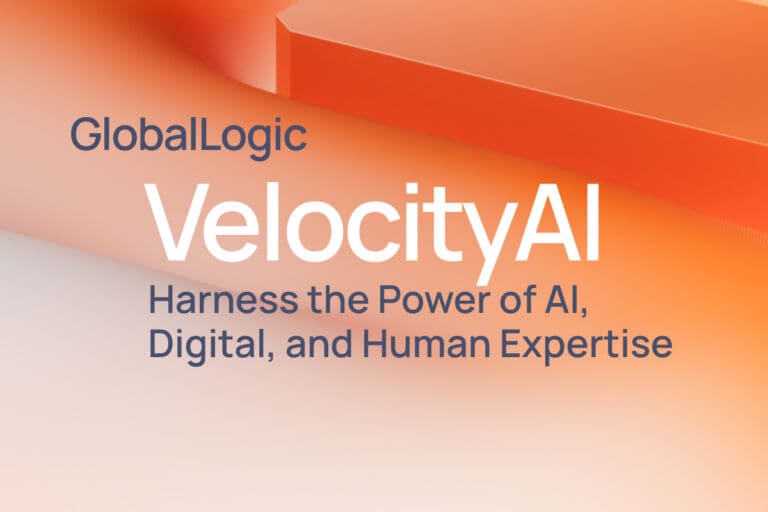- Services
Technology Capabilities
Technology Capabilities- Product Strategy & Experience DesignDefine software-driven value chains, create purposeful interactions, and develop new segments and offerings.
- Digital Business TransformationAdvance your digital transformation journey.
- Intelligence EngineeringLeverage data and AI to transform products, operations, and outcomes.
- Software Product EngineeringCreate high-value products faster with AI-powered and human-driven engineering.
- Technology ModernizationTackle technology modernization with approaches that reduce risk and maximize impact.
- Embedded Engineering & IT/OT TransformationDevelop embedded software and hardware. Build IoT and IT/OT solutions.
- Industries
- GlobalLogic VelocityAI
- Insights
BlogsDecember 16, 2024Gene LeybzonAccelerating Digital Transformation with Structured AI Outputs
This code produces the following output that can be imported into the candidate trackin...
 BlogsOctober 30, 2024Yuriy Yuzifovich
BlogsOctober 30, 2024Yuriy YuzifovichAccelerating Enterprise Value with AI
Discover how financial services integrations are transforming from standalone offerings...

- About Us
Press ReleaseGlobalLogicMarch 11, 2025GlobalLogic Launches VelocityAI to Harness the Power of AI, ...
VelocityAI combines advanced AI technologies with human expertise, helping businesses r...
 Press ReleaseGlobalLogicJanuary 10, 2025
Press ReleaseGlobalLogicJanuary 10, 2025GlobalLogic Announces Leadership Change: Srini Shankar Appointed ...
SANTA CLARA, Calif.–January 10, 2025– GlobalLogic Inc., a Hitachi Group Com...

- Careers
Published on October 3, 2023IT Leaders in Banking & Finance Prepare for Business in the Metaverse
View all articles Deborah KennedyAssociate Vice President,Client EngagementShareRelated Content
Deborah KennedyAssociate Vice President,Client EngagementShareRelated Content Yuriy Yuzifovich4 March 2025
Yuriy Yuzifovich4 March 2025 GlobalLogic26 February 2025View All Insights
GlobalLogic26 February 2025View All Insights GlobalLogic20 February 2025
GlobalLogic20 February 2025Let's start engineering impact together
GlobalLogic provides unique experience and expertise at the intersection of data, design, and engineering.
Get in touchFinancial ServicesDespite uncertainty around regulation, millions are already interacting inside the metaverse, a market Ernst & Young expects could contribute over $3 trillion to global GDP by 2031. With the metaverse poised to dramatically change how banks, insurance companies, and other financial institutions engage with customers, IT leaders are focused intently on the challenges and opportunities ahead.Banking and financial services IT professionals gathered recently for an immersive, one-hour VR roundtable discussion in the metaverse, co-hosted by GlobalLogic and The CXO Institute. In The Future of Banking: Doing Business in the Metaverse, hosted by GlobalLogic CTO Steven Croke and facilitated by yours truly, participants took a deep dive into innovative next-generation banking and finance solutions on the horizon and questions on how banks will feed consumer needs for personalization, interaction, convenience, and security.
In this article, you’ll find the highlights from our session, including top questions surfacing in banking and finance organizations as each plans its metaverse roadmap – plus your personal invitation to join GlobalLogic’s Monthly Metaverse Meetups for banking leaders and innovators. Let’s begin by exploring the most pressing challenges and opportunities digital leaders face as metaverse and VR adoption gradually increase.
Why Metaverse Planning is on Banking & Financial Service Roadmaps
Changing consumer demographics and rapidly advancing VR technologies drive massive opportunities for forward-thinking brands, and banking is ripe for disruption. A recent GlobalLogic survey revealed that 90% of Gen Z are willing to turn to big tech and nonbanks for better and faster banking services, and most participants in that demographic had “no idea why” they’d go into a branch when most basic things can be done quicker and easier online.
The same survey found that 80% of Gen Z respondents felt there was insufficient advice available about banking and financial products and that they did not understand how things like mortgages were structured. Investing was a key theme across our research interviews, and most participants brought the idea up unprompted. Inflation, skyrocketing housing costs, and increasing volatility in the job market are weighing heavily on consumers’ minds, and freelancing in various forms is becoming more common.
For all their diverse needs across employment, banking, shopping, and entertainment, people are looking for more immersive, engaging, and personalized experiences. Increasingly, they’re finding those in the metaverse – particularly Gen Z and Millennials (spanning ages 14 to 40), around 40% of whom have already used VR technology in some way. According to Deloitte, close to 50% of this cohort say they spend more time interacting with others on social media than in real life. Further, Gartner predicts that by 2026, 25% of people will spend at least one hour a day in the metaverse for work, shopping, education, social, and/or entertainment.
This state of current affairs in which consumers are seeking out financial advice and services and increasingly doing so online ought to cause concern for banks, Croke shared with The Future of Banking participants. How will your business respond to an emerging group of consumers who do not feel they need banks or understand them properly and have little or no desire to enter a branch?
Metaverse Presents Opportunities for Education, Support & Customer Experience
The banking sector’s adoption of cryptocurrency and blockchain has increased significantly in recent years and will account for 4% and 4.5% of metaverse revenue in 2025, respectively. But beyond these earliest and best-known DeFi products, how will your bank build trust in the metaverse and make virtual interactions more compelling than the bricks-and-mortar equivalent?
Several banks are setting up lounges or virtual branches as an entry point to the metaverse and using the space to establish a presence and nurture customer relationships. Offering education, support, and advice on financial products in the metaverse can enable financial services brands to engage Gen Z even as VR banking matures.
HSBC, for example, purchased virtual real estate in The Sandbox to engage and connect with sports, e-sports, and gaming enthusiasts. Is this the right idea?
IT leaders attending The Future of Banking event had mixed feelings regarding virtual banking services. They expressed skepticism about the likelihood of adoption without a specific incarnation of virtual offerings that fires the customer’s imagination. Banks will need to give customers compelling reasons to go to the metaverse to complete actions they can already do with mobile banking applications or develop actions they cannot experience with mobile or web interfaces. The next biggest hurdle will be understanding what that will look like across the industry.
Transitioning to a VR Financial Services Mindset
For one institution, KB Kookmin Bank in South Korea, it meant creating a virtual branch where simple transactions, such as remittances, can be managed at a teller window.
“We’re already seeing several banks now setting up branches… they’re essentially providing lounges for users to go into those branches and try and make them, effectively, a place to get a conversation going with customers,” Croke shared. Roundtable participants were asked whether they see replicated real-world experiences as the model for transactions in the Metaverse.
One delegate, a CTO for a large insurance brand, said he felt that HSBC’s approach made more sense. “History is littered with examples of trying to replicate something in a new medium and it not working as well… doing something different in a different medium would probably be a more fruitful direction forward.”
Perhaps a hybrid approach would be easier than a metaverse-native experience? Banks may consider creating products that mimic something in the real world with a VR twin; for example, mortgage applicants could access and explore a digital twin of the property they’re considering.
IT leaders must also consider how metaverse-native experiences might be handled in the future. “If you buy a ticket to a concert in the Metaverse, why would you not purchase that with a payment product that is Metaverse native?” Croke said.
Exploring Options for Metaverse Finance & Banking Products
Even if product development is still far off on the long-term planning horizon, bank leaders should be thinking today about broadening their ideas of what financial products could look like within the metaverse context.
“We’re already seeing value items being created in the Metaverse,” Croke said. “We’re seeing collectibles being created. We’re seeing equities, we’re seeing art being created. How are these going to be financed? How can one purchase those products? And if you think about storage, where do we store that value?”
Delegates questioned whether we should expect to see a dual business model, with banks in the Metaverse handling cryptocurrencies transacted through the banks or Metaverse ATMs. We tend to think today that the metaverse will not be able to handle traditional banking products. However, as one delegate pointed out, we may see this change once banking finds a strong use case to drive initial adoption and create demand for more services. “I think it’s about starting with a very niche, single-use case that’s killer, and everybody wants to use it, but I think that’s yet to be found,” he said.
Visualizations offer an interesting way to explore the possibilities today. “If I want to have a 3D visualization of risk, rather than today’s 2D diagram, for example… in 3D, I can move stuff with my fingers and share that information with other traders,” one delegate shared. “I think that’d be very helpful. So, I visualize value addition. I think that’s a pivotal point where Metaverse can start adding value to existing processes.”
The Maturation and Growth of Decentralized Finance
The huge uptake in cryptocurrency and NFTs has led to a new virtual economy, even after the initial buzz died down. This is a borderless, secure, and fast environment in which DeFi enables financial transactions to be performed by entities directly using smart contracts without financial intermediaries.
Still, we’ve not yet reached a point of maturity where people feel comfortable undertaking a number of activities and transactions in the metaverse outside of Gen Z and gamers. We have this community of early adopters who are already quite demanding and discerning in their metaverse experiences alongside a far larger population still trying to wrap their minds around the possibility.
Whether adoption and user behavior drive regulation or increased regulation opens the door to greater adoption remains to be seen. The rise of central bank digital currencies and expressed desire from Singapore monetary (likely the furthest ahead at this point) raises many questions about DeFi and its impact on metaverse adoption and maturation. Even so, it is clear today that banks must prepare now to put their arms around this economy as the experiment and learn now so they can be best positioned to move fast and innovate as opportunities open up.
Final Thoughts & Continuing the Conversation
Internet users rely on multiple apps for authentication. But does the Metaverse require that we now own our digital identity? And if we move across multiple platforms, doesn’t a unique digital identity become a prerequisite?
How do we combat money laundering and fraud in a virtual environment where a criminal can open a crypto wallet, fund their wallet with cryptocurrency, and buy a parcel on a chosen metaverse platform? Once the parcel is bought, they can build a store to hold their NFTs and sell NFTs as a cover for illicit products in real life.
These are just a few of the metaverse questions and challenges facing IT leaders in banking worldwide right now.
GlobalLogic will continue the conversation in our monthly Metaverse Innovation Meetups beginning Friday, November 10, to be held in VR. Join us for ongoing discussions about:
- current trends in banking in the metaverse
- successes in the industry and lessons learned
- brainstorming prototypes that will help define the app that will ultimately successfully drive VR adoption
We’re growing a community of like-minded innovators and business leaders to talk through ideas and help move banking in the metaverse forward in real ways. Will you join us?
Click here to email me your request for an invitation to GlobalLogic’s Monthly Metaverse Meetup.
